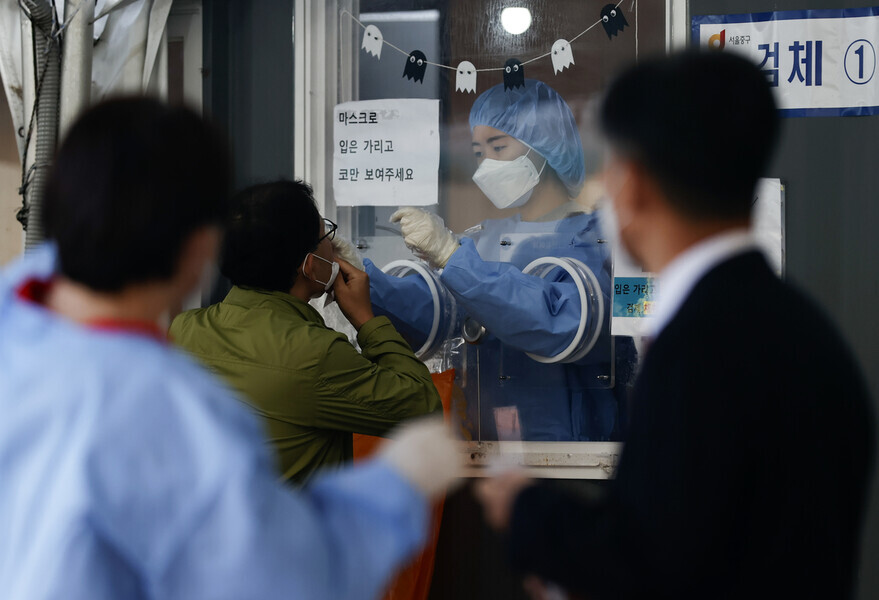hankyoreh
Links to other country sites 다른 나라 사이트 링크
Unvaccinated account for 75.6% of recent COVID-19 deaths in S. Korea

Unvaccinated people accounted for 75.6% of recent deaths from COVID-19, while people aged 60 and over represented 85.6%, statistics show.
According to an explanation provided Monday by the Central Disaster and Safety Countermeasures Headquarters (CDSCH), of the 389 people who died from COVID-19 during the preceding five weeks, 294 (75.6%) had not received any doses of a COVID-19 vaccine. The total also included 333 people, or 85.6%, who were aged 60 and over.
Son Young-rae, head of the social strategy group for the Central Disaster Management Headquarters, said, “It appears the risk of death [from COVID-19] increases among people who have not been vaccinated and people who are older.”
“We once again urge seniors who have not completed their vaccinations to receive their doses,” he said.
The number of new daily confirmed cases ticked upwards Monday, the day that marked the beginning of easing of restrictions as part of a “gradual return to everyday life.”
Between Oct. 24 and 30, the average daily number of domestic confirmed cases was 1,716, up 28.2% from 1,339 for the preceding week from Oct. 17 to 23. The weekly basic reproduction number was calculated at 1.03, rising above 1 again after remaining below 0.9 for the preceding three weeks (0.89, 0.86 and 0.88).
The basic reproduction number is an indicator showing the average number of people infected by a given COVID-19 patient. A number above 1 indicates a trend of increasing infections, while a number below 1 shows that transmission is being slowed.
The average daily number of patients in severe or critical condition — one of the key indicators for the program of returning to everyday life — stood at 333 last week, down by 10 from 343 the week before.
The intensive care hospital bed occupancy rate for the greater Seoul region was 58.5%, including rates of 58% for Seoul, 61% for Gyeonggi Province, and 53% for Incheon. Nationally, the occupancy rate stood at 45.2%.
“For the past five weeks, [the number of severe and critical patients] has been holding steady in the 300–400 range,” said Park Hyang, director of the disease control supervision team for the Central Disaster Management Headquarters.
“If we consider that the occurrence of severe and critical symptoms in patients leads to the use of intensive care beds, we should not expect any problems with intensive care beds if the number [of severe and critical patients] stays below 500,” she predicted.
By Lee Jae-ho, staff reporter
Please direct questions or comments to [english@hani.co.kr]

Editorial・opinion
![[Correspondent’s column] The real reason the US is worried about Chinese ‘overcapacity’ [Correspondent’s column] The real reason the US is worried about Chinese ‘overcapacity’](https://flexible.img.hani.co.kr/flexible/normal/500/300/imgdb/original/2024/0510/5217153290112576.jpg) [Correspondent’s column] The real reason the US is worried about Chinese ‘overcapacity’
[Correspondent’s column] The real reason the US is worried about Chinese ‘overcapacity’![[Editorial] Yoon’s gesture at communication only highlights his reluctance to change [Editorial] Yoon’s gesture at communication only highlights his reluctance to change](https://flexible.img.hani.co.kr/flexible/normal/500/300/imgdb/original/2024/0510/7717153284590168.jpg) [Editorial] Yoon’s gesture at communication only highlights his reluctance to change
[Editorial] Yoon’s gesture at communication only highlights his reluctance to change- [Editorial] Perilous stakes of Trump’s rhetoric around US troop pullout from Korea
- [Guest essay] Preventing Korean Peninsula from becoming front line of new cold war
- [Column] The state is back — but is it in business?
- [Column] Life on our Trisolaris
- [Editorial] Penalties for airing allegations against Korea’s first lady endanger free press
- [Editorial] Yoon must halt procurement of SM-3 interceptor missiles
- [Guest essay] Maybe Korea’s rapid population decline is an opportunity, not a crisis
- [Column] Can Yoon steer diplomacy with Russia, China back on track?
Most viewed articles
- 1[Correspondent’s column] The real reason the US is worried about Chinese ‘overcapacity’
- 2[Editorial] Yoon’s gesture at communication only highlights his reluctance to change
- 3Yoon rejects calls for special counsel probes into Marine’s death, first lady in long-awaited presse
- 4[Book review] Who said Asians can’t make some good trouble?
- 5Korea likely to shave off 1 trillion won from Indonesia’s KF-21 contribution price tag
- 6Nuclear South Korea? The hidden implication of hints at US troop withdrawal
- 7Korea poised to overtake Taiwan as world’s No. 2 chip producer by 2032
- 8Yoon voices ‘trust’ in Japanese counterpart, says alliance with US won’t change
- 9[Column] S. Korea’s low birth rate means its no time to gamble with the future
- 10Ex-President Moon Jae-in’s next career move? Bookshop owner